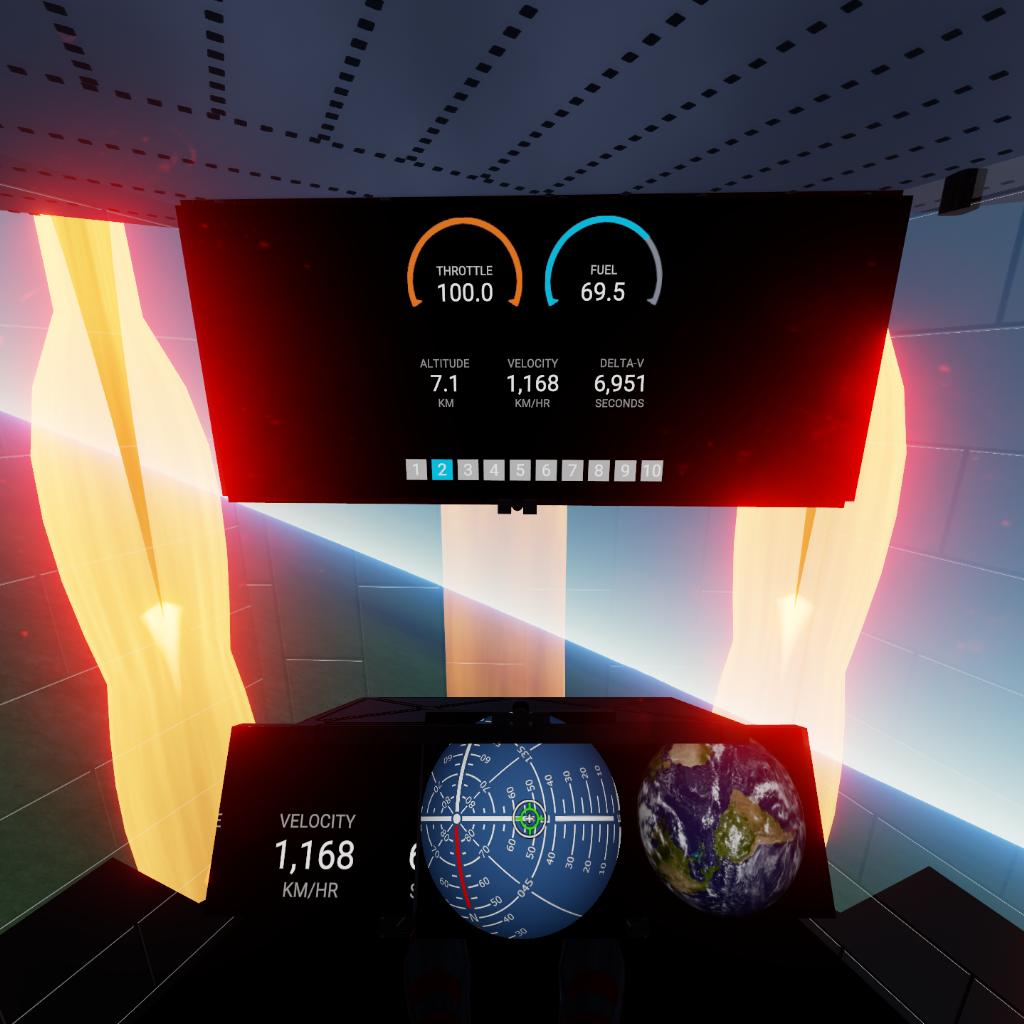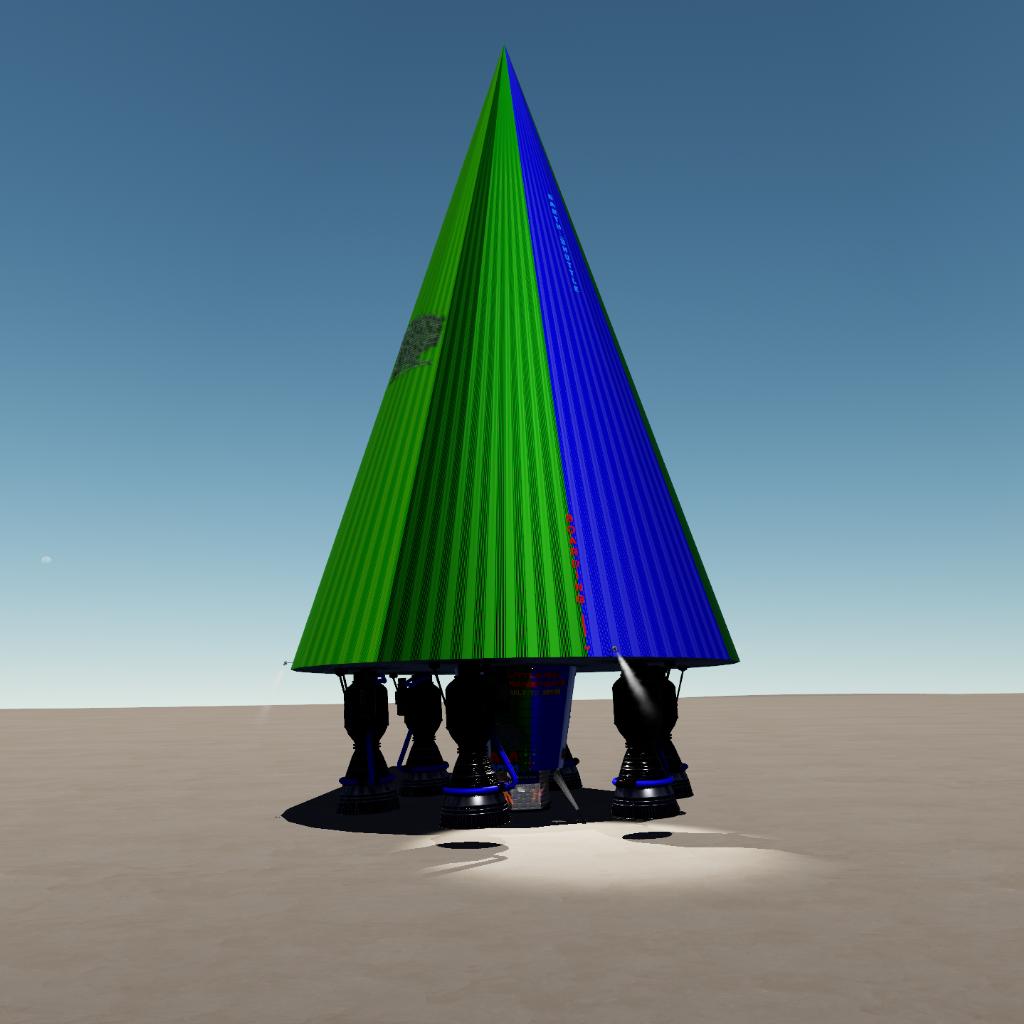* LIAM EARTH *
ULTRA High Efficiency SSTO EARTH Shuttle
Carreer Mode Compatible
FULLY UNTINKERED / FULL (HEAT) DAMAGE / NO REFUELING
INTRODUCTION
First a few personal words. This little project was very hard to achieve for me. It took me many hours to finally get this craft, which is not only a SSTO but can also dock at a space station / different craft and then return to Earth (!) without refueling, taking 5 Astronauts up and down.
Starting from the Cape gives you 400m/s delta-v in orbit for rendevous, which is enough for climbing from the 125km orbit to 200km for example. There is no room for inclination changes, that is clear.
Kourou gives you 500m/s for orbit maneuvers.
The most complicated part is by far the re-entry. Solving this I choose this big cone main fuel tank, which collects most of the re-entry heat doing a permanent spin rotation during descend - protecting the parts below and distributing the heat equally.
When reaching 25km the spinning is stopped and the hole vehicle is flipped by 180degree retrograde to work as a parachute !
RCS system and main batteries are protected INSIDE the main tank under the shield skin.
To keep this as realistic as possible I reduced the fuel mass inserted into the tanks to 95% to get the space needed for this.
Even with this there is an initial brake from 7.8km/s to 7.05km/s necessary to survive the brutal descend back to mother Earth.
Trillions of parts exploded during my experiments ...
Now: No damage at all. Only fuel costs (2 million $) to use this.
Specs
LIAM Earth is a (space trained) colonist shuttle for Earth - designed for maximum efficiency and low production & maintenance cost.
The main objective of this project was to develop a design for a RETURNABLE EARTH SSTO craft (Single Stage To and From Orbit without refueling).
The engines are based on HydroLOX, which limits the mass of this complicated craft.
It is completely untinkered to be as close as possible to the nowadays reality. So the tanks are shaped to maximize efficiency with simultaneous streamlining.
They are only filled up to 95% to give space for components integrated under the tanks heat shield layer.
The tempered quartz glass of the cabin gives a fantastic view of Earth.
Indispensable for such a spaceship is the ability to return to the surface from orbit without refueling.
This craft is very easy to board and leave (on the ground and in orbit, where the docking tunnel hatch in the center of the cabin can be used to enter a space station).
For up to 5 colonists (up and down).
WARNING
During ascent there is a 5g protection limit allowing all colonists to use this craft. During descent there is a deceleration peak of 10g during re-entry. This requires the passengers to lie down on the cabines ceiling into the prepared high-g-damping-beds. Only space experienced colonisted and trained personal are adviced to use the descend route.
Activation groups
- 2 Auto Launch
- 5 Auto Landing
- 7 Lights
- 8 Landing Legs
- 9 Main Hatch
- 10 RCS
Slider
- Slider 1 : [-1..0] Stairs Bridge - [0..1] Pilot Console
Vizzy program
- Energetically optimized ascent program (AG2)
- Earth atmosphere optimized descent program (AG5)
Acknowledgements
Tested on Earth (Cape Canaveral and Kourou) with fabulous HyperPatch Solar System 2.0
GENERAL INFO
- Predecessor: LIAM little
- Created On: Windows
- Game Version: 1.2.109.0
- Price: $50,844k
- Number of Parts: 199
- Dimensions: 38 m x 19 m x 19 m
PERFORMANCE
- Total Delta V: 11.0km/s
- Total Thrust: 10.1MN
- Engines: 11
- Wet Mass: 5.78E+5kg
- Dry Mass: 41,558kg
STAGES
| Stage | Engines | Delta V | Thrust | Burn | Mass |
|---|---|---|---|---|---|
| 1 | 6 | 11.0km/s | 10.1MN | 3.7m | 5.78E+5kg |










@RichGWall Just did it, it's easy in the first step. But may influence some other things I don't know. Just started a rocket from equator going to 340km orbit, velocity correct now.
You can also easily change HyperPatch 2.0 Earth Atmosphere in Planet Studio.
The only problem is that we then have no common reference, as neither HyperPatch nor SolarCompany seem to be willing to change anything we recommend.
Whereby I have to say that the HyperPatch 2.0 atmosphere is good so far, only the Juno heat shields are somehow wrongly modeled for the Earth's atmosphere.
@RichGWall Yes. Or we can correct the beautiful solar system from SolarCompany ourselves. I'll see if changing the radius in Planet Studio is that difficult. I've never worked with it before, but it can't be that difficult.
@TomKerbal Another idea would be to continue to use 1.5.3 and import the 2.0 Mars into it.
@TomKerbal I agree. It's been a long time since I took Thermodynamics.
Your chart from the engineering toolbox would do nicely.
@RichGWall "But in reality, we know the atmosphere of Earth extends out to a density of the inverse square of the altitude"
I think it is more an exponential decrease up to the Karman line (100km) (https://en.wikipedia.org/wiki/Barometric_formula).
Here is, what I mean:
EarthAtmosphericDensity
Showing an approx. exponential decrease up to approx. 100km (or 140km with good will), then something different. In 400km there is still micro atmosphere as you also mentioned.
Side note: the inverse square is rather a not so suitable approximation I think, because its derivative ( -2/x^3) is so different from the exponential derivative (-1/e^x)
@RichGWall I fully agree with nearly all you said.
Perhaps one more addition:
"There is Droo, a planet based on fantasy. I assume the terrestrial physics are accurate to a planet its size and mass, but is it?"
Given its size the density of Droo has to be so extremely high, that no known element in our universe (as far as we know!) exists, that could produce such a gigantic matter density. Same as in KSP btw.
"It may be that Hyperpatch's SS 2.0 is the most accurate, but Juno's components just will not work well in it?" Yes, I think so, too.
"And so, what about heatshields? " I think modding these could solve most of the atmospheric problems. So using HyperPatch 2.0 in combination with modded heatshield would be a better solution than now. We can tinker Heatshields, but then they are not usable in career mode.
@TomKerbal
The Bottom Line
Juno is centered around the Juno system and the planet Droo with 3 moons etc, etc.
We already know that Juno omits two important orbital elements, The 'Inclination of a planets Rotation' and 'obliquity of ecliptic.' One has to ask why the programmers would leave these out?
The second issue is with the atmospheric profiles of planets. Are they realistic?
There is Droo, a planet based on fantasy. I assume the terrestrial physics are accurate to a planet its size and mass, but is it? I have confidence the orbital mechanics are accurate to orbital velocities using Newtonian Physics. But is the atmospheric profile? Who knows?
When I compared Hyperpatch's 1.5.3 Earth atmospheric profile to Droo, that it performed similarly for reentry, this could be a fallacy in logic. Especially if Droo is fantasy. Maybe Hyperpatch's SS 2.0 is closer to reality? It would take many manhours for us to figure this out ourselves.
The artificial line between air and space is 60 miles, which equals closely 100 Km.
But in reality, we know the atmosphere of Earth extends out to a density of the inverse square of the altitude. Then there is drag. Juno includes it but how accurate is it? Since it is included, I would have to guess its 90 % accurate. So, are the components mass and drag somewhat accurate?
If we used an atmospheric model that went past an altitude of 200 Km it would be more accurate, but for simulation purposes, time warp could not be used below that altitude because a ship's orbit should degrade over time and eventually deorbit and burn.
The ISS's orbit averages about 400 Km to avoid this very problem but still has to perform stabilizing maneuvers to maintain a stable orbit because of the micro drag our atmosphere causes.
For modeling purposes here and to keep time warp in the game, I would suggest we use 200 Km as an atmospheric limit and create an atmospheric profile as accurate to reality as possible. But this is a tremendous amount of work. It may be that Hyperpatch's SS 2.0 is the most accurate, but Juno's components just will not work well in it?
Next, what about the components? Would their properties be realistic in a realistic environment? Already the engines need an adjustment like 'Realistic Engine overhaul" or 'RSS Rebalance' for SS 1.5.3 and 2.0. The fuel tanks have the "RealFuelTanks" mod. And so, what about heatshields? Are they 'within parameters'?
So it may be that none of this is realistic, and we are left to create similes and understand this sim was never meant to be realistic.
Where to begin? I have no idea. All of it, any of it could just be beyond our capabilities.
I am sure that many in this forum have most of these answers, but I don't see or expect any answers coming from them.
@RichGWall Same as me
@TomKerbal Yes, it is, but I'm a night owl.
@RichGWall Quite late in the States, isn't it ? :)
@TomKerbal Sure, I'll give it a go.
@RichGWall
We could test this new system :
https://www.simplerockets.com/PlanetarySystems/View/y841pZ/Solar-System
@SatelliteTorifune You cannot survive Earth re-entry. Or it is extremely difficult.
You cannot survive Earth re-entry
@TomKerbal return mission is possible to create, as the project hasn't been in that progress, if you want smth like "RSS Mars Sample and Return mission"you can make one yourself
@SatelliteTorifune I did this whole investigation mainly because of your RSS career. You can't do return missions yet. I think this is very interesting for your mod :)
dude plz don't mention me if there is nothing to do with the custom career
@RichGWall @SatelliteTorifune
So I'm giving up on the subject for now. As I read on Wikipedia, the Mercury capsule only had a mass of 2 tons. I don't know how to do that with Juno without tinkering.
So it's probably best if we adopt RichGWall's suggestion of an atmospheric altitude of 60 km for Earth. That would be the same as in SolSys 1.5.3.
Good night for tonight, Tom.
@RichGWall @SatelliteTorifune Probably the easiest way would be to change the heat damage factor in the RSS career game (like that slider in the sandbox games).
I do not know how this could be possible, but I will check some xml files.
@RichGWall @SatelliteTorifune
This is what I get in Planet Studio :
atmosphereDensityThreshold="1E-07" => 120km atmosphere (nearly impossible re-entry, exept for LIAM of course ;-) )
atmosphereDensityThreshold="1E-04" => 80km (maybee possible for Mercury style capsules, I will examine)
atmosphereDensityThreshold="1E-03" => 60km (Safe for re-entry)
I cannot change existing Solar Systems because of checksum errors . So if SatelliteTorifune changes his Solar System for the career mod, it will be good for delivery.
But I cannot say, which one is the correct one. A tradeoff could be atmosphere up to 80km. I will further examine.
@RichGWall @SatelliteTorifune
Now I am convinced: BÄMM
https://www.simplerockets.com/c/g497ml/Mercury-Smallest-Possible-Test
O.k., I am ready now for discussion :)
Perhaps for now, Coping the Atmospheric parameters from 1.5.3 to 2.0 would be a good band-aid. Both are Hyperpatch's work and allows for a continuity of Authorship. Or we hire an atmospheric guru to do all the Atmosphere's of the Solar System.
But you are the captain and I do not want to steal your thunder. Your progress very much counts.
@RichGWall @SatelliteTorifune
O.k., that is something which has to be considered for the career mod.
If it is nearly impossible to re-entry (we will see), than this makes no sense.
A Mercury capsule must be able to re-entry. Well, I am not quite convinced, that this is not possible in SolSys 2.0 , but probably that is the case. So we have a problem here.
@RichGWall I found it (I think). In 1.5.3 the following is missing in the xml - file for Earth :
atmosphereDensityThreshold="1E-07"
I also tested it a few minutes ago: Atmosphere in 1.5.3 starts at 60km altitude.
In 2.0 at 120km (I know you know).
@TomKerbal I see what you mean. We are limited by the parameters of what can be programed into the sim. Atmospheric renderings are very difficult to be modeled with 100% accuracy. An average still works for modeling if the end result is achieved after reentry. I'm sure some of the planet gurus in here already know much of this.
Here is 1.5.3
@RichGWall Ah, o.k., I checked Planet Studio. fadeDistance is irrelevant for us.
What could (?) be interesting is the parameter "Mean Gamm" which should be the heat capacity ratio (for an ideal gas should be = 1.4). But I think it only influences the temperature here.
Reducing surfaceAirDensity="1.2000000476837158" and/or meanMassPerMolecule="28" would probably "help", but this is cheating.
What could be a strategy to continue is clearifying, why your Mars capsule does not burn in SolSys 1.5.3 but in 2.0 .
I try to find and install SolSys 1.5.3 now.